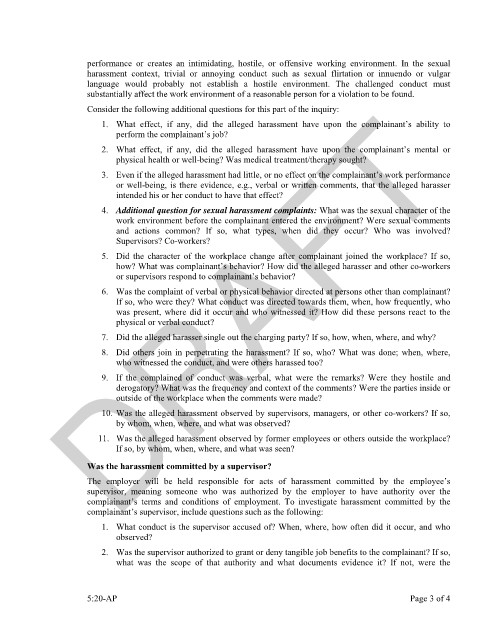Page 896 - draft
P. 896
performance or creates an intimidating, hostile, or offensive working environment. In the sexual
harassment context, trivial or annoying conduct such as sexual flirtation or innuendo or vulgar
language would probably not establish a hostile environment. The challenged conduct must
substantially affect the work environment of a reasonable person for a violation to be found.
DRAFT
Consider the following additional questions for this part of the inquiry:
1. What effect, if any, did the alleged harassment have upon the complainant’s ability to
perform the complainant’s job?
2. What effect, if any, did the alleged harassment have upon the complainant’s mental or
physical health or well-being? Was medical treatment/therapy sought?
3. Even if the alleged harassment had little, or no effect on the complainant’s work performance
or well-being, is there evidence, e.g., verbal or written comments, that the alleged harasser
intended his or her conduct to have that effect?
4. Additional question for sexual harassment complaints: What was the sexual character of the
work environment before the complainant entered the environment? Were sexual comments
and actions common? If so, what types, when did they occur? Who was involved?
Supervisors? Co-workers?
5. Did the character of the workplace change after complainant joined the workplace? If so,
how? What was complainant’s behavior? How did the alleged harasser and other co-workers
or supervisors respond to complainant’s behavior?
6. Was the complaint of verbal or physical behavior directed at persons other than complainant?
If so, who were they? What conduct was directed towards them, when, how frequently, who
was present, where did it occur and who witnessed it? How did these persons react to the
physical or verbal conduct?
7. Did the alleged harasser single out the charging party? If so, how, when, where, and why?
8. Did others join in perpetrating the harassment? If so, who? What was done; when, where,
who witnessed the conduct, and were others harassed too?
9. If the complained of conduct was verbal, what were the remarks? Were they hostile and
derogatory? What was the frequency and context of the comments? Were the parties inside or
outside of the workplace when the comments were made?
10. Was the alleged harassment observed by supervisors, managers, or other co-workers? If so,
by whom, when, where, and what was observed?
11. Was the alleged harassment observed by former employees or others outside the workplace?
If so, by whom, when, where, and what was seen?
Was the harassment committed by a supervisor?
The employer will be held responsible for acts of harassment committed by the employee’s
supervisor, meaning someone who was authorized by the employer to have authority over the
complainant’s terms and conditions of employment. To investigate harassment committed by the
complainant’s supervisor, include questions such as the following:
1. What conduct is the supervisor accused of? When, where, how often did it occur, and who
observed?
2. Was the supervisor authorized to grant or deny tangible job benefits to the complainant? If so,
what was the scope of that authority and what documents evidence it? If not, were the
5:20-AP Page 3 of 4

